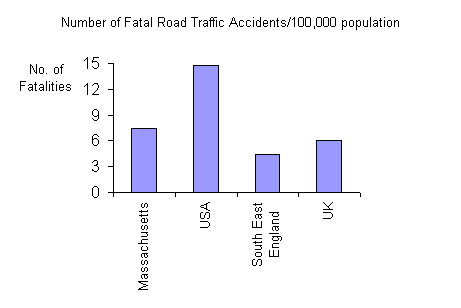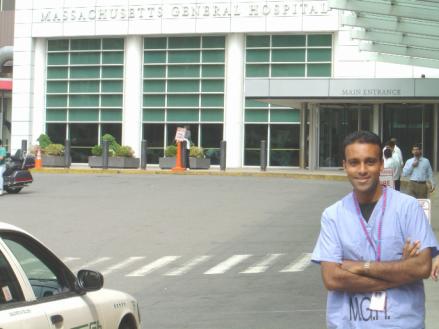
Founded in 1811, Massachusetts General Hospital (MGH) is the third
oldest general hospital in the United States and the oldest and largest in New
England. The 868-bed bed hospital admits approximately 42,000 inpatients each
year with an average length of stay of 5.97 days.
Its extensive outpatient department housed in the Wang building receives
more than 1.2 million visits each year.
The ER department handles nearly 75,000 visits annually. MGH also has 62 operating rooms performing 32,000 operations each year.
MGH also employs over 16,000 employees of which 3,700 are medical staff.
Apart from the size MGH had many differences to UK hospitals to me the most notable differences were the patient education centre and the IT facilities.
The well furnished patient education centre is located just off the main foyer and contains a large collection of patient leaflets and free internet access for patients to access the patient part of the hospitals website with links to a range of resources. Interestingly this room was always packed, to me this reflected the attitude of Americans to their health. This is something I saw throughout my elective in that many patients knew what they wanted from the doctor before their consultation and were very educated about their illnesses. At least this patient education centre in the modern age of information on the internet did serve to educate the patients of MGH correctly.
The IT facilities for me were a real eye opener in that all patient notes, results of investigations, letters, correspondences and X-rays and other radiology were put on computer. The advantage of this were that I felt the notes were well organised easily accessible as a result of this different system to the UK. From an orthopaedic point of view this meant that radiology images could be amplified and scrutinised easily on a computer screen.
The hospital rooms including the patient bays and outpatient rooms each had an abundance of plasma screens and computers at hand. Here different levels of access were offered to members of staff for example nurses could access the notes whereas fellows and attendings could access them online as well as add information.
MGH is also well resourced with
a large emphasis on research conducting
the largest hospital-based research program in the United States, with an annual
research budget of more than $300 million. During my elective I was glad to have
submitted a case report (appendix 1) for publication the research of which was
linked to a $15,000 grant for the department.
It also boasts an impressive past and
reputation. Famously in 1846 the use of ether as an anaesthetic was first used
in surgery at MGH, a museum marking this is housed in a building aptly named the
ether dome within the hospital. In July 2001 the MGH was also named one of the
country's best hospitals by U.S. News and World Report for the twelfth year,
ranking third nationwide.
With regards to teaching and its organisation MGH and Boston’s other major hospital the Brigham and Womens Hospital are the main teaching hospitals of Harvard Medical School. These are the founding members of Partners Healthcare which is the framework by which resources are organised.
Based in Boston Partners Healthcare was founded in 1994 and is an integrated network of hospitals and medical professionals providing patient care, medical research, clinical education and community health programmes.
As well as its founding hospitals Partners includes primary care and smaller community based hospitals and includes more than 1,000 primary care physicians and 3,000 hospital specialists.
As with the majority of similar institutions in the US this hospital offers its services around a private framework. Partners became a success since 1994 as a measure of easing financial competition and financial structuring between MGH and the Brigham and Womens. Interestingly when I enquired as to the cost of a hospital bed at MGH, I was promptly given the reply of it is a case of the hospital charging a patient rather than how much it costs.
This reflects the situation in the US in that the majority of the population take out private health insurance primarily in the form of Medicare. However the hospital does not turn down patients and then addresses the issue of ‘charging’. In a substantial amount of cases in some departments this can amount to a quarter of cases no cost can be recuperated.
Concerning the orthopaedic services at MGH approximately 6,000 inpatient admissions and 30,000 ambulatory encounters are seen annually.
The following table shows comparative statistics for Southampton General (1,2):
|
|
Massachusetts General Hospital |
Southampton General Hospital |
|
Inpatient Admissions/year |
42,000 |
30,660 |
|
Orthopaedic And Trauma Admissions/year |
6,000 |
4,424 |
The most frequent cases I encountered as part of orhto A that specialised in trauma were linked to road traffic accidents. The incidences of fatal road traffic accidents in Massachusetts and the US per population can be compared with those in the South East England and the UK (1,4):
|
|
Number of Fatal Road Traffic Accidents/100,000 Population |
|
Massachusetts |
7.48 |
|
USA (population 292,470,469) |
14.79 |
|
South East England |
4.4 |
|
UK (population 59,030,600) |
6.0 |
Thus
both regions are below the national averages, this can be shown graphically:


Main entrance to Massachusetts General Hospital – the hospital has 868 beds and admits 42,000 inpatients each year.